SKILL 62: Canine Endotracheal Intubation
INTERMEDIATE VETERINARY NURSING SKILL
We recommended you watch the instructional video prior to attempting intubation if you have not seen a demonstration by the Clinical Skills Tutor.
- Select the appropriate tube sizes. We recommend grabbing a selection of 3 sizes.
- Place the tip between the nares of the nose, this is roughly the same size as the patient’s trachea
- Inflate your cuff to check for leaks (leave inflated for 30 mins in the real world), deflate before use. Check ET tube is clean and dry.
- Measure the length of the tube and make a note of how long it can be inserted.
- Measure the tube from the canines to the thoracic inlet (top of the shoulder).
- Ask your assistant to hold the head in a sternal position
- Hold by the upper jaw by the lateral aspects of the gums under the lips
- Straighten and extend the neck to open the airway and allow intubation
- Do not scruff as this can distort the soft tissues, place the hand behind the base of the skull and life and extend the neck to place the head and neck in a straight line
- Use the laryngoscope to facilitate visualisation of the larynx. Press at the base of the tongue to drop the epiglottis. Do not use the laryngoscope blade on the epiglottis as this can damage the fragile cartilage.
- Place the tube angling down following the curve of the trachea.
- Advance the ET tube until the canines are at the point you measured to.
- Tie around the ET tube (not too tightly) and secure behind the canines, tying around the muzzle of back of the neck with a bow (again not too tightly).

Due to the nature of the activity, this task cannot be practiced at home in its entirety. Please speak to your senior nurse or supervisor to practice performing this task in clinic.
That said, one of the areas many student struggle with is learning to hold the laryngoscope and ET tube whilst manipulating the tongue out the way. You could tie a rag to the end of a piece of hose. The rag being the tongue, and the hose being the trachea.
You can then borrow a smaller gauge ET tube (or grab one that is being thrown out) and if possible, even a laryngoscope (but you could also improvise that with some cardboard and something as the handle). Get a friend to hold the hose, or use a clamp or vice to hold the hose steady. Anything that helps you to learn to hold the tongue and laryngoscope in one hand, and the ET tube steady in the other, can help you to learn this skill much quicker in practice.
Got another idea? Shoot it through to us and we’ll give it a crack. Got a picture of you doing this? We’d love to see it.
ACVN Blog: Endotracheal Intubation – Yes, veterinary Nurses can learn it too
https://vetnurse.com.au/2018/03/07/endotracheal-intubation/
ACVN Short Course: Anaesthesia and Surgical Analgesia
https://vetnurse.com.au/product/anaesthesia-analgesia/
ACVN Skills Workshops: Veterinary Nursing Skills has this station to learn
https://vetnurse.com.au/vetnursingworkshops/
